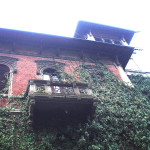La principale causa di degrado della villa è imputabile al lungo periodo di abbandono con la totale assenza di qualsiasi intervento manutentivo. L’obiettivo d’intervento è stato quello di ristabilire l’unità dell’opera attraverso il recupero degli aspetti formali e architettonici nel rispetto della patina del tempo, delle sue stratificazioni, dei materiali, dei colori per giungere al recupero del suo carattere. Da qui, per capire e conoscere l’edificio sono state svolte lunghe e accurate indagini preliminari: ricerche storiche in archivio, catasto e rilievi metrici, fotografici e un’ approfondita analisi delle patologie del degrado descrivendo per ciascun elemento lo stato di conservazione. Sono state eseguite prove in situ sui tipi di materiali da impiegare cercando di utilizzare prodotti e tecniche nel rispetto dell’edificio. Sono state effettuate analisi chimiche e fisiche prelevando alcuni campioni di materiale dell’edificio per capire la loro composizione e il loro stato di conservazione: i prelievi dei campioni riguardano le malte interne ed esterne dell’edificio.
Le operazioni di restauro sono iniziate dal solaio di copertura: la struttura lignea si trovava in un gravissimo stato conservativo e le infiltrazioni d’acqua avevano reso le travi completamente marcescenti con conseguenti crolli in alcune zone. Tutta l’orditura è stata ripristinata ed è stato riposizionato l’originale manto di copertura costituito da tegole marsigliesi di colore scuro.
Dopo la rimozione della vegetazione che, in alcune porzioni di facciata, aveva alterato la percezione degli elementi architettonici con diffusa crescita di macro e microrganismi si è provveduto alle operazioni di disinfestazione per mezzo di un biocida e successivo risciacquo con acqua nebulizzata.
La superficie muraria si trovava in buono stato di conservazione: non è stato necessario rimuovere e sostituire alcun mattone. Mentre per le fughe sono state rimosse le malte di allettamento prive di consistenza, stilatura dei giunti con malte della stessa composizione di quelli originali. Trattamento preventivo contro la formazione e la crescita nel tempo di alghe e licheni. La protezione del laterizio è stata eseguita con prodotti a base di siliconi.
The main cause of the deterioration of the villa is to be attributed to the long period of time that it stood abandoned, with absolutely no maintenance work done on it at all. The aim of the intervention has been to re-establish the unity of the building by saving the formal and architectural features from the ravages of time, its stratifications, the materials, the colours, to manage to recover its character without making the mistake of creating a historical fake. So, in order to understand and get to know the building, long and accurate preliminary studies have been carried out: historical research in the archives and land registry, and metrical and photographical inquiries, and a careful and accurate analysis of the pathologies of its deterioration, each element described according to its state of preservation. Tests have been carried out on site on the kinds of materials to use, trying to choose products and techniques that will respect the building. Chemical and physical analyses have been performed, with samples of the material of the building itself in order to understand their composition and state of preservation: the samples regard the internal and external cement of the building. Restoration operations began from the roof: the wooden structure was in a very bad state of abandon and leaking water had rotted the wooden beams completely so that in some places they had collapsed. All the wooden structure was restored and all the original roofing of dark “Marseilles” tiles was put back into place. After the removal of all the vegetation that in some parts of the facade had concealed the shape of the architectural lineaments with widespread growth of macro and micro-organisms, everything was disinfested with biocide products after which it was washed down with sprayed water. The wall surface was found to be in a good state of repair: there was no need to remove and replace a single brick. In the case of leakages the crumbling cement was removed, and the joints were washed and pointed with cement of the same composition as the original. Preventive treatment was given against the formation and accumulation over time of moss and lichens. The brickwork was protected with silicon-based products.








Leave a comment